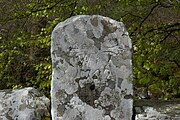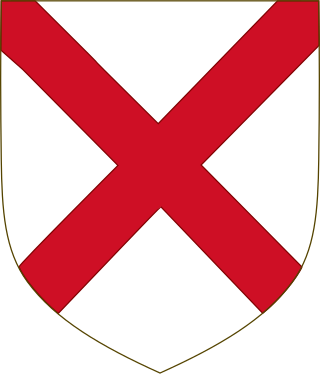
The FitzGerald dynasty is a Hiberno-Norman noble and aristocratic dynasty, originally of Cambro-Norman and Anglo-Norman origin. They have been peers of Ireland since at least the 13th century, and are described in the Annals of the Four Masters as having become "more Irish than the Irish themselves" or Gaels, due to assimilation with the native Gaelic aristocratic and popular culture. The dynasty has also been referred to as the Geraldines and Ireland's largest landowners. They achieved power through colonisation and the conquest of large swathes of Irish territory by the sons and grandsons of Gerald de Windsor. Gerald de Windsor was the first Castellan of Pembroke Castle in Wales, and became the male progenitor of the FitzMaurice and FitzGerald Dynasty. His father, Baron Walter FitzOther, was the first Constable and Governor of Windsor Castle for William the Conqueror, and was the Lord of 38 manors in England, making the FitzGeralds one of the "service families" on whom the King relied for his survival. Some of its members became the Black Knights, Green Knights and White Knights.
The title King of the Britons was used to refer to a ruler, especially one who might be regarded as the most powerful, among the Celtic Britons, both before and after the period of Roman Britain up until the Norman invasion of Wales and the Norman conquest of England. Britons were the Brittonic-speaking peoples of what is now Wales, England and southern Scotland. The Britons contributed as ethnic ancestors of the native British population including the Welsh, Cornish, and Scottish people but also of the Bretons.
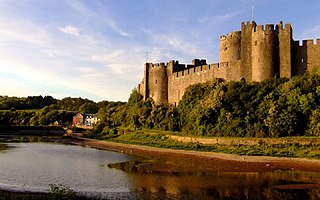
Gerald de Windsor, aliasGerald FitzWalter, was an Cymro-Norman lord who was the first Castellan of Pembroke Castle in Pembrokeshire. Son of the first Norman-French Constable of Windsor Castle, and married to a Welsh Princess daughter of the King of Deheubarth, he was in charge of the Norman forces in south-west Wales. He was also steward and governor for the Norman magnate Arnulf de Montgomery. His descendants were the FitzGerald dynasty, as well as the FitzMaurice, De Barry, and Keating dynasties of Ireland, who were elevated to the Peerage of Ireland in the 14th century. He was also the ancestor of the prominent Carew family, of Moulsford in Berkshire, the owners of Carew Castle in Pembrokeshire and of Mohuns Ottery in Devon.
This article is about the particular significance of the year 1846 to Wales and its people.

Edward Lowry Barnwell was a British antiquarian and schoolmaster who was headmaster of Ruthin School, Denbighshire for 26 years.
This is a list of Sheriffs of Merionethshire. The historic county of Merioneth was originally created in 1284. The administrative county of Merioneth was created from the historic county under the Local Government Act 1888.

The Cambrian Archaeological Association was founded in 1846 to examine, preserve and illustrate the ancient monuments and remains of the history, language, manners, customs, arts and industries of Wales and the Welsh Marches and to educate the public in such matters. The association's activities include sponsoring lectures, field visits, and study tours; as well as publishing its journal, Archaeologia Cambrensis, and monographs. It also provides grants to support research and publications.

Archaeologia Cambrensis is a Welsh archaeological and historical scholarly journal published annually by the Cambrian Archaeological Association. It contains historical essays, excavation reports, and book reviews, as well as society notes and accounts of field visits. The journal has included "much valuable material on the manuscripts, genealogy, heraldry, toponymy, folklore and literature of Wales".
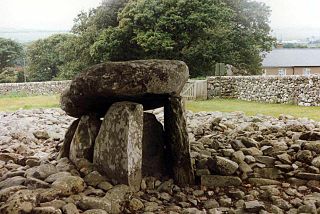
Dyffryn Ardudwy is a village, community and electoral ward in the Ardudwy area of Gwynedd, Wales. It comprises several small, almost conjoined, villages including Coed Ystumgwern, Llanenddwyn, Llanddwywe, Talybont and Dyffryn Ardudwy. It is situated on the main A496 coast road between Harlech and Barmouth. The ward had a population of 1,540 according to the 2011 census.

The Royal House of Mathrafal began as a cadet branch of the Welsh Royal House of Dinefwr, taking their name from Mathrafal Castle. They effectively replaced the House of Gwertherion, who had been ruling the Kingdom of Powys since late Roman Britain, through the politically advantageous marriage of an ancestor, Merfyn the Oppressor. King Bleddyn ap Cynfyn would join the resistance of the Anglo-Saxon King Harold Godwinson, against the invasion of William the Conqueror, following the Norman Conquest of England. Thereafter, they would struggle with the Plantagenets and the remaining Welsh Royal houses for the control of Wales. Although their fortunes rose and fell over the generations, they are primarily remembered as Kings of Powys and last native Prince of Wales.

William Watkin Edward Wynne was a Welsh Conservative Party politician and antiquarian.

John FitzThomas, 1st Baron Desmond was the son of Thomas Fitzmaurice, Lord OConnello by his wife Ellinor, daughter of Jordan de Marisco, and sister of Geoffrey de Marisco, who was appointed justiciar of Ireland in 1215. He was the grandson of Maurice FitzGerald, Lord of Lanstephan.

Eisingrug is a rural hamlet near Harlech, Gwynedd, Wales. It is located to the southeast of Porthmadog.
Harry Longueville Jones (1806–1870) was a Welsh archæologist, artist, Inspector of Schools for Wales and leading founding member of the Cambrian Archaeological Association.
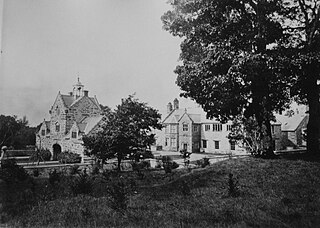
Richard Vaughan was a Welsh politician who sat in the House of Commons from 1628 to 1629.

Maenan Abbey was a monastic religious house located in Maenan, Conwy, Wales. It is situated near Llanrwst.

The Lordship of Bromfield and Yale was formed in 1282 by the merger of the medieval commotes of Marford, Wrexham and Yale. It was part of the Welsh Marches and was within the cantref of Maelor in the former Kingdom of Powys.

Talhenbont Hall is a Grade II listed building on a 100-acre (40 ha) estate in Gwynedd, Wales. Until it was renamed in the 19th or 20th century, the building was known as Plas Hen.
Robert Williams (1810–1881) was a Welsh Anglican clergyman and Celtic scholar.

Ellis ap Griffith or Elissau ap Gruffudd, was the Baron of Gwyddelwern in Denbighshire, Wales, and the grandnephew of Owen Glendower, Prince of Wales. Following his family defeat during the Glyndwr Rising, his branch inherited the co-representation of the Royal House of Mathrafal, and were immortalized by William Shakespeare in the history play Henry IV. Through his mother Lowrie, he inherited the lordship of his grandfather, Tudor Glendower, and by marriage, the estate of Plas-yn-Yale. By this union, he became the founder of the House of Yale, represented by the Yale family, later known in America as the benefactors of Yale University.





